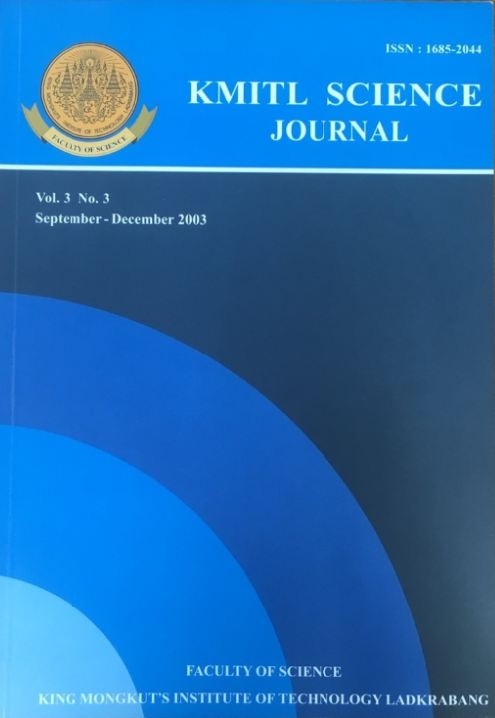A Sensitive Chemiluminescent Assay for Aflatoxin B1
Main Article Content
Abstract
In this study a chemiluminescent label was substituted for an enzyme marker used in AFB1 ELISA and the minimum detection limits of the direct/modified indirect competitive chemiluminescence immunoassay (CIA), the direct competitive CIA (2 step method), the direct competitive CIA (1 step, 30 min method), and the direct competitive CIA (1 step, 5 min method) were shown to be 10.0, 5.1, 5.6, and 6.8 pg ml-1 respectively. In a direct comparison between different labeling methods but using the same antibodies, the direct competitive CIA (1 step, 5 min method) is superior in sensitivity to the AFB1 ELISA (detection limit 200 pg ml-1). In addition to an increase in sensitivity, the assay time was also reduced. The sensitivity of the assay was not affected by 6.25% (v/v) methanol and required a 1:8 dilution of the peanut extract [using 80% (v/v) methanol as extracting solvent] was required to avoid matrix interference.
Keywords: aflatoxin B1, chemiluminescent label, enzyme marker, immunoassay
Corresponding author: E-mail: varipin@health.moph.go.th
Article Details
Copyright Transfer Statement
The copyright of this article is transferred to Current Applied Science and Technology journal with effect if and when the article is accepted for publication. The copyright transfer covers the exclusive right to reproduce and distribute the article, including reprints, translations, photographic reproductions, electronic form (offline, online) or any other reproductions of similar nature.
The author warrants that this contribution is original and that he/she has full power to make this grant. The author signs for and accepts responsibility for releasing this material on behalf of any and all co-authors.
Here is the link for download: Copyright transfer form.pdf
References
[2] International Agency for Research on Cancer Monographs. Evaluation of carcinogenic risk of chemicals to humans, IARC Monograph Supp, 7, 1987, 83-87.
[3] Food and Agriculture Organization/World Health Organization, Annex 1-Aflatoxins: Summary and Conclusions, The Joint FAO/WHO Expert Committee on Food Additives, 49th meeting, 1997, 16-17.
[4] Stenman, U.H. Quantitation of antigen. In: Herzenberg, L.A. Weir, D.M. Herzenberg, L.A. and Blackwell, C. Weir’s handbook of experimental immunology. 5 th ed. Massachusetts, Blackwell Science, 1996, pp. 45.1-45.7.
[5] Ekins, R.P. and Chu, F.W. Multianalyte microspot immunoassay: microanalytical “compact disk” of the future, Clinical Chemistry, 37, 1991, 1955-1967.
[6] Alkan, S. Akdis, C. and Towbin, H. Chemiluminescent and enzyme-linked immunoassays foe sensitive detection of human IFN-γ, Journal of Immunoassay, 15, 1994, 217-238.
[7] Dudley, R.S. Chemiluminescence immunoassay: An alternative to RIA, Laboratory Medicine, 21, 1990, 216-22.
[8] Rongen, H.A.H. Hoetelmans, R.M.W. Bult, A. and Van Bennekom, W.P. Chemiluminescence and immunoassays, Journal of Pharmacological and Biomedical Analysis, 12, 1994, 433-462.
[9] Candlish, A.A.G. The development of monoclonal antibody based enzyme immunoassays for ochratoxin A and aflatoxin B1. Glasgow, University of Strathclyde, 1987.
[10] Candlish, A.A.G. Stimson, W.H. and Smith, J.E. A monoclonal antibody to aflatoxin B1: Detection of the mycotoxin by enzyme immunoassay, Letters in Applied Microbiology, 1, 1985, 57-61.
[11] Goodbrand, I.A. Stimson, W.H. and Smith, J.E. A monoclonal antibody to T-2 toxin, Letters in Applied Microbiology, 5, 1987, 97-99.
[12] Chu, F.S. Development of antibodies against aflatoxins. In: Eaton, D.L. and Groopman, J.D. The toxicology of aflatoxins. New York, Academic Press, 1994, pp. 451-490.
[13] Fan, T.S.L. and Chu, F.S. An indirect ELISA for detection of aflatoxin B1 in corn and peanut butter, Journal of Food Protection, 47, 1984, 263-266.
[14] Richardson, A.P. Kim, J.B. Barnard, G.J. Collins, W.P. and McCapra, F. Chemiluminescence immunoassay of plasma progesterone, with progesterone-acridinium ester used as the labeled antigen, Clinical Chemistry, 31, 1985, 1664-1668.
[15] Kawamura, O. Nagayama, S. Sato, S. Ohtani, K. Ueno, I. and Ueno, Y. A monoclonal antibody based enzyme-linked immunosorbent assay for aflatoxin B1 in peanut products, Mycotoxin Research, 4, 1988, 75-88.
[16] Swinscow, T.D.V. In: British Medical Association. Statistics at square one. 8 th ed. London, Dawson and Global, 1983, pp. 21-28.
[17] Whitaker, T.B. Dickens, J.W. and Giesbrecht, F.G. Effect of methanol concentration and solvent: peanut ratio on extraction of aflatoxin from raw peanut, Journal of the Association of Official analytical Chemists, 67, 1984, 35-36.
[18] Whitaker, T.B. and Dickens, J.W. Optimal methanol concentration and solvent/peanut ratio for extraction of aflatoxin from raw peanuts by modified AOAC method II, Journal of the Association of Official Analytical Chemists, 69, 1986, 508-10.
[19] El-Nakib. Pestka, J.J. and Chu, F.S. Determination of aflatoxin B1 in corn, wheat, and peanut butter by enzyme-linked immunosorbent assay and solid phase radioimmunoassay, Journal of the Association of Official Analytical Chemists, 64, 1981, 1077-1082.
[20] Ram, B.P. Hart, L.P. Shotwell, O.I. and Pestka, J.J. Enzyme-linked immunosorbent assay for aflatoxin B1 in naturally contaminated corn and cottonseed, Journal of the Association of Official Analytical Chemists, 69, 1986, 904-907.
[21] Chu, F.S. Fan, T.S.L. Zhang, G-S. Xu, Y.C. Faust, S. and McMahon, P.L. Improved enzyme-linked immunosorbent assay for AFB1 in agricultural commodities, Journal of the Association of Official Analytical Chemists, 70, 1987, 854-857.


